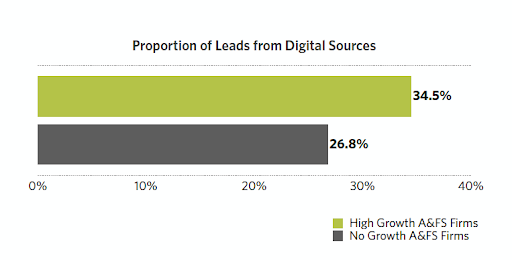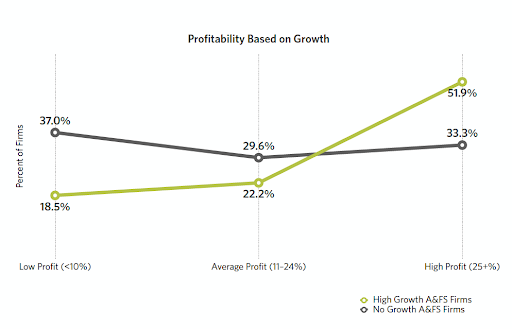Written by: Alexis Whitehouse
Most firms carefully consider the return they expect from any investment they make, but this is particularly true for accounting and financial services firms. After all, it’s what they do for their clients (among other things). Hinge Research Institute’s 2021 High Growth Study reveals what high-growth firms are doing to maximize their return on marketing investment both in dollars and in effort.
First let’s define what we mean by a high-growth firm. In our research, we define a high-growth firm as one with a compound annual growth rate of 20% or greater over a three-year period. Now let’s explore three macro-level marketing strategies high-growth firms commonly employ to achieve results.
1. Conduct Research Regularly
There is a saying, “You don’t know what you don’t know.” So it makes sense that firms conducting regular research to better understand their clients’ evolving needs and the current state of their client’s market are able to make more informed strategic marketing decisions. Research provides the insight to connect with their clients’ and prospects’ key issues and evolving concerns and inform marketing strategies that yield a greater return on marketing investment. In fact, high-growth firms are more than 2X more likely to conduct research than their no-growth peers.

Research is not a one-and-done activity. We cannot overemphasize the importance of conducting research at least annually to keep your finger on the pulse of the marketplace. Your clients’ priorities and needs change over time, economic and political events may have significant impacts on business, and competition is ever-present and ever changing.
Not all research is the same. There are different methodologies and ways to structure research in order to achieve specific goals. A firm going through a merger that will result in a rebrand is interested in learning different things than a firm with a client base that has been affected by new regulations, so it’s important that each research initiative be structured to provide the insight and understanding you seek.
2. Allocate Resources Appropriately
When you set out to accomplish something, it’s important that you position yourself for success. At the outset, consider what it will take to get you where you want to go and then dedicate the necessary resources to achieve your goal—the people, time, dollars, etc. that are required to garner the desired results and return on marketing investment.
We liken it to building a factory. You don’t expect a factory to start producing a product and revenue without first making an investment in the plant, machinery and people (brainpower) needed to successfully produce results. This doesn’t mean that you have to have an exorbitant marketing budget. In fact we’ve found that high-growth firms actually spend less than average on marketing than their average or no-growth peers. And high-growth firms typically allocate less effort to traditional marketing techniques, which are often costly, and invest more effort in digital marketing. So it’s not a matter of investing more in marketing. Success comes from knowing where to invest your limited resources.

3. Track Results
Once you’ve determined which strategies to adopt and which tactics to invest in, you must continually track results and recalibrate to optimize your marketing program and gain the most return on marketing investment. No-growth firms tend to focus on bottom-line metrics such as the number of new clients acquired. In contrast, high-growth firms track a wider group of variables spanning the entire marketing pipeline, including brand awareness, website traffic, social media engagement, lead generation and conversion rate. By tracking the full marketing cycle you can pinpoint exactly where in the pipeline you are succeeding and where there is room to improve.
Bottom Line:
High-growth firms not only grow faster but they’re also much more likely to be highly profitable than their no-growth peers.

They conduct research on a regular basis to stay informed about the marketplace, their clients needs and their own performance. They use research findings to establish strategies and allocate budget and effort to techniques that provide maximum return on marketing investment. And high-growth firms continually track multiple metrics throughout their pipeline and adjust as needed to stay at the forefront of their market. If your firm is not already a high-growth performer, there’s no time to waste. Start implementing these strategies today.
Related: 10 Online Lead Generation Techniques for Professional Services

